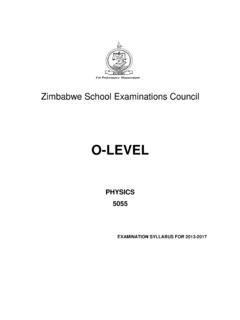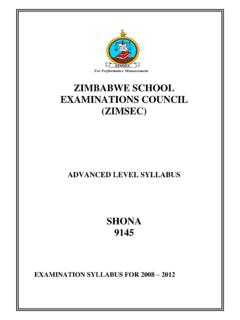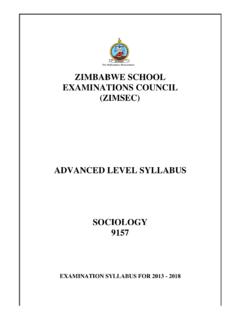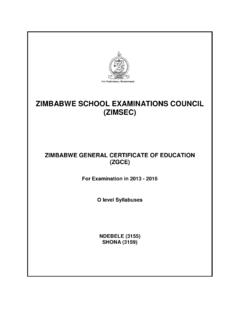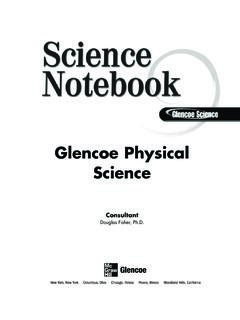Transcription of ZIMBABWE SCHOOL EXAMINATIONS COUNCIL (ZIMSEC) ORDINARY ...
1 ZIMBABWE SCHOOL EXAMINATIONS COUNCIL ( zimsec ) ORDINARY LEVEL SYLLABUS physical SCIENCE (5009) examination SYLLABUS FOR 2013 2015 2 A. INTRODUCTION This syllabus assumes a knowledge of the content of the two year ZIMBABWE Junior Certificate (ZJC) Science Syllabus. It prepares pupils for studies in physical sciences beyond O level as well as being a worthwhile qualification for those not proceeding with study beyond this level. It places less emphasis on factual recall of material and more emphasis on the understanding and application of scientific concepts, principles and skills. Applications of science and technology to agricultural, environmental, social and economic issues are included to extend subject concepts and skills. A practical and investigative approach must be adopted in teaching this syllabus. This will serve to develop the skills and abilities necessary to achieve the stated aims and objectives.
2 B. AIMS The aims of the syllabus are to help pupils: 1 develop interest, and curiosity, in science; 2 develop concepts and skills that are relevant to the study and practice of physical science; 3 appreciate and enjoy physical science and its methods of enquiry; 4 develop creativity, initiative and skills of enquiry; 5 develop good practices for health and safety; 6 develop accuracy and precision, objectivity and integrity; 7 recognise the usefulness and limitations of science; 8 apply scientific method in other disciplines and in everyday life; 9 appreciate the beneficial and detrimental effects of the applications of science; 10 recognise that the study and practice of science are inter-related and are subject to economic, technological, social, political, ethical and cultural influences; 11 communicate scientific information effectively; 12 participate in the technological development of ZIMBABWE ; 3 13 develop interest in, and participate in, caring for the local and global environment.
3 C. ASSESSMENT OBJECTIVES The following objectives reflect those aspects of the aims that will be assessed. Specific behavioural learning objectives are stated in each section of the syllabus. KNOWLEDGE AND UNDERSTANDING Pupils should be able to demonstrate knowledge and understanding of: scientific instruments and apparatus, techniques of operation and aspects of safety; scientific units, terminology, symbols and conventions; scientific quantities and how they are determined; scientific phenomena, facts and laws, definitions, concepts, theories and models; personal, social, economic and environmental implications of scientific applications. HANDLING INFORMATION AND SOLVING PROBLEMS Pupils should be able to demonstrate, in familiar and unfamiliar situations, their ability to: extract information relevant to a particular context from data presented in diagrammatic, symbolic, graphical, numerical or verbal form; use data to recognise patterns, formulate hypotheses and draw conclusions; translate information from one form to another; communicate logically and concisely; explain facts, observations and phenomena in terms of scientific laws, theories and models; explain the effects of technological applications on the environment; 4 make logical decisions based on the examination of evidence and arguments; apply scientific principles, formulae and methods to solve qualitative and quantitative problems.
4 Suggest explanations of unfamiliar facts, observations and phenomena; identify the practical constraints affecting scientific investigations. EXPERIMENTAL SKILLS Pupils should be able to: follow instructions for practical work; plan, organise and carry out experimental investigations; select appropriate apparatus and materials for experimental work; use apparatus and materials effectively and safely; make accurate, systematic observations and measurements, recognising the variability of experimental measurements; observe, measure and record results of experiments systematically; identify possible sources of error in experimental procedures; draw conclusions and make generalisations from experiments; extract information from data presented in diagrammatic, graphical or numerical form. 5 WEIGHTING OF ASSESSMENT OBJECTIVES ASSESSMENT OBJECTIVES WEIGHTING Papers 1 and 2 Knowledge and understanding 55% Handling information 45% paper 3 or paper 4 Experimental skills 100% D.
5 ASSESSMENT SCHEME paper Type of paper Duration Marks paper Weighting 1 Theory 1h 40 30% 2 Theory 2h 15min 100 50% 3 Practical examination 1h 30min 40 20% 4 Alternative to Practical (Written) 1h 40 20% Candidates will be required to enter for Papers 1 and 2 and either paper 3 or paper 4. 6 paper 1 Theory (1 hour, 40 marks) This paper will consist of 40 compulsory multiple choice items. paper 2 Theory (2 hours 15 min, 100 marks) Section A (40 marks, 55 min) will consist of eight compulsory short-answer and structured questions based equally on the physics and chemistry sections of the syllabus. Section B (30 marks, 40 min) will be based on the chemistry section of the syllabus. It will consist of three free-response questions of fifteen marks each and each designed to take 20 minutes. Candidates will be required to answer any two questions. All questions will be designed to give the same weighting to assessment objectives.
6 Section C (30 marks, 40 min) will be based on the physics section of the syllabus. It will consist of three free-response questions of fifteen marks each and each designed to take 20 minutes. Candidates will be required to answer any two questions. All questions will be designed to give the same weighting to the assessment objectives. paper 3 Practical examination (1 hour 30 min, 40 marks) This paper is designed to assess the extent to which a candidate displays competence in practical skills. Candidates will be expected to be familiar with apparatus appropriate to SCHOOL physical sciences laboratories and techniques of the use of such apparatus. The practical examination will consist of two questions of twenty marks each, one based on the physics section and the other on the chemistry section of the syllabus. Candidates will be expected to carry out the experiments from the instructions and notes given in the question papers.
7 Chemistry Question Candidates may be asked to carry out exercises based on: (a) quantitative experiments involving the use of a pipette, a burette and an indicator such as methyl orange or screened methyl orange; if the titrations other than acid/alkali are set, full instructions and other necessary information will be given; (b) speeds of reaction; 7 (c) measurement of temperatures based on a thermometer with 1 C graduations; (d) problems of an investigatory nature, possibly including suitable organic compounds; (e) simple paper chromatography; (f) filtration; (g) tests for oxidising and reducing agents as specified in the syllabus. (h) identification of ions and gases as specified in the syllabus. The question papers will provide notes on qualitative analysis and data for the use of candidates in the examination see data sheets (i) and (ii). Candidates may also be required to perform some simple calculations.
8 Physics Question The question is designed to test candidates abilities to: (a) follow written instructions for the assembly and use of provided apparatus, using ray-tracing equipment, wiring up simple electrical circuits; (b) select, from given items, the measuring device suitable for the task; (c) carry out specified manipulation of the apparatus, when determining a quantity such as the extension per unit load for a spring, when testing or identifying the relationship between two variables such as that between the potential difference ( ) across a wire and its length, when comparing physical quantities such as the heat capacity of two metals; (d) take readings from a measuring device, including - reading a scale with appropriate precision/accuracy, - making consistent use of significant figures, - interpolating between scale divisions, - allowing for zero errors, where appropriate, - taking repeated measurements to obtain an average value; (e) record their observations systematically, with appropriate units; (f) process data as required; 8 (g) present their data graphically, using suitable axes and scales (appropriately labelled and plotting the points accurately); (h) take readings from a graph by interpolation and extrapolation; (i) determine a gradient, intercept or intersection on a graph; (j) draw and report a conclusion or result clearly; (k) indicate how they carried out a required instruction; (l) describe precautions taken in carrying out a procedure.
9 (m) give reasons for making a choice of items of apparatus; (n) comment on a procedure used in an experiment and suggest improvements. paper 4 Alternative to Practical (1 hour, 40 marks) A written paper consisting of 4 compulsory short-answer and structured questions, 2 on Chemistry and 2 on Physics. These questions will be designed to test familiarity with laboratory practical procedures. Questions may be set requiring candidates to: (a) record readings from diagrams of apparatus; (b) describe, explain, comment on or suggest experimental arrangements, techniques and procedures; (c) complete tables of data and/or plot graphs; (d) take readings from graphs by interpolation and extrapolation; (e) determine a gradient, intercept or intersection on a graph; (f) interpret, draw conclusions from and evaluate experimental (including graphical) data; (g) describe tests for gases, ions, oxidising and reducing agents and/or draw conclusions from such tests; (h) perform simple calculations; (i) draw clear labelled line drawings; 9 (j) explain, suggest and/or comment critically on safety precautions taken and possible improvements to techniques and procedures; (k) identify possible sources of error.
10 NOTE: examination questions on all papers may be set requiring candidates to apply knowledge to novel situations. E. METHODOLOGY Emphasis is placed on the acquisition of experimental skills though practical experience. Experiments should be planned and designed in advance. A pupil-centred problem-solving approach should be adopted. Individual and group work is encouraged. Emphasis must be on the understanding of concepts rather than on the memorisation of specific examples that illustrate these concepts. The syllabus is a two-year course of study. A minimum of six teaching periods (3 hours) per week required. Teachers may use an integrated, co-ordinated or topic-based approach or any other suitable style of organisation and delivery. Emphasis on investigations and practical work is expected. Schools are encouraged to rearrange the topics to suit their own conditions.
